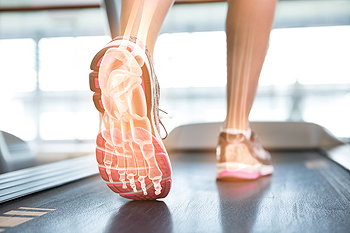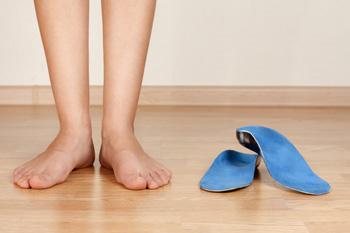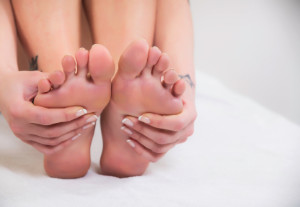Items filtered by date: September 2020
Four Exercises for the Feet
Exercising and stretching the feet is important for maintaining foot health. There are several different exercises that can help strengthen the feet. Weaving your fingers between each of your toes, and then stretching and massaging the toes and ball of your foot, can help relieve bunion symptoms. Standing on a towel and scrunching it up with your toes is a good stretch to help with plantar fasciitis pain. Lifting your heels off the floor then slowly bringing them back down several times is a good stretch for strengthening the ankles and calves. Flexing your toes outwards and then squeezing them in can help restore flexibility and relieve pain from bunions and hammertoes. For more information about stretching the feet, speak with a podiatrist today.
Stretching the feet is a great way to prevent injuries. If you have any concerns with your feet consult with Leonora Fihman, DPM from California. Our doctor will assess your condition and provide you with quality foot and ankle treatment.
Stretching the Feet
Being the backbone of the body, the feet carry your entire weight and can easily become overexerted, causing cramps and pain. As with any body part, stretching your feet can serve many benefits. From increasing flexibility to even providing some pain relief, be sure to give your feet a stretch from time to time. This is especially important for athletes or anyone performing aerobic exercises, but anyone experiencing foot pain or is on their feet constantly should also engage in this practice.
Great ways to stretch your feet:
- Crossing one leg over the others and carefully pull your toes back. Do 10-20 repetitions and repeat the process for each foot
- Face a wall with your arms out and hands flat against the wall. Step back with one foot and keep it flat on the floor while moving the other leg forward. Lean towards the wall until you feel a stretch. Hold for 30 seconds and perform 10 repetitions for each foot
- Be sure not to overextend or push your limbs too hard or you could risk pulling or straining your muscle
Individuals who tend to their feet by regular stretching every day should be able to minimize foot pain and prevent new problems from arising.
If you have any questions, please feel free to contact our offices located in Encino and Brentwood, Los Angeles, CA . We offer the newest diagnostic and treatment technologies for all your foot care needs.
Read more about Stretching Your FeetPoor Foot Biomechanics
 There are a variety of biomechanical issues in the feet that can lead to potential injury. Some of these issues include fallen arches, over-pronation, or supination. Pronation occurs when the foot rolls inward at the ankle, the midfoot bulges and the arch flattens. Supination occurs when the foot rolls out at the ankle and the arch is raised, which leads to issues absorbing shock. When poor foot biomechanics can cause specific foot injuries such as plantar fasciitis, Achilles tendonitis, or a Morton’s neuroma, pain in the ankles, heels, and arches is a common result. Poor foot biomechanics can also lead to issues in other parts of the body that include knee pain, hip pain, shin splints and lower back pain. If you are concerned about your foot biomechanics, consult with a podiatrist.
There are a variety of biomechanical issues in the feet that can lead to potential injury. Some of these issues include fallen arches, over-pronation, or supination. Pronation occurs when the foot rolls inward at the ankle, the midfoot bulges and the arch flattens. Supination occurs when the foot rolls out at the ankle and the arch is raised, which leads to issues absorbing shock. When poor foot biomechanics can cause specific foot injuries such as plantar fasciitis, Achilles tendonitis, or a Morton’s neuroma, pain in the ankles, heels, and arches is a common result. Poor foot biomechanics can also lead to issues in other parts of the body that include knee pain, hip pain, shin splints and lower back pain. If you are concerned about your foot biomechanics, consult with a podiatrist.
If you have any concerns about your feet, contact Leonora Fihman, DPM from California. Our doctor can provide the care you need to keep you pain-free and on your feet.
Biomechanics in Podiatry
Podiatric biomechanics is a particular sector of specialty podiatry with licensed practitioners who are trained to diagnose and treat conditions affecting the foot, ankle and lower leg. Biomechanics deals with the forces that act against the body, causing an interference with the biological structures. It focuses on the movement of the ankle, the foot and the forces that interact with them.
A History of Biomechanics
- Biomechanics dates back to the BC era in Egypt where evidence of professional foot care has been recorded.
- In 1974, biomechanics gained a higher profile from the studies of Merton Root, who claimed that by changing or controlling the forces between the ankle and the foot, corrections or conditions could be implemented to gain strength and coordination in the area.
Modern technological improvements are based on past theories and therapeutic processes that provide a better understanding of podiatric concepts for biomechanics. Computers can provide accurate information about the forces and patterns of the feet and lower legs.
Understanding biomechanics of the feet can help improve and eliminate pain, stopping further stress to the foot.
If you have any questions please feel free to contact our offices located in Encino and Brentwood, Los Angeles, CA . We offer the newest diagnostic and treatment technologies for all your foot and ankle needs.
Who Is Most Likely to Get Gout?
 Gout is a type of arthritis that typically affects the big toe joints. This condition is caused by a buildup of uric acid in the bloodstream, which forms crystals in the joints. This typically causes pain, and hot, stiff, swollen joints. Men are more likely to get gout than women. Sometimes, gout can be caused by genetic factors, so if you have a family member with gout, you may be more at risk of developing it yourself. Your chances of getting gout can also increase because of certain lifestyle factors, such as being overweight, drinking alcohol, or eating too many foods that are rich in purines. If you are suffering from gout, it is suggested that you seek the care of a podiatrist, who can diagnose and treat your condition.
Gout is a type of arthritis that typically affects the big toe joints. This condition is caused by a buildup of uric acid in the bloodstream, which forms crystals in the joints. This typically causes pain, and hot, stiff, swollen joints. Men are more likely to get gout than women. Sometimes, gout can be caused by genetic factors, so if you have a family member with gout, you may be more at risk of developing it yourself. Your chances of getting gout can also increase because of certain lifestyle factors, such as being overweight, drinking alcohol, or eating too many foods that are rich in purines. If you are suffering from gout, it is suggested that you seek the care of a podiatrist, who can diagnose and treat your condition.
Gout is a foot condition that requires certain treatment and care. If you are seeking treatment, contact Leonora Fihman, DPM from California. Our doctor will treat your foot and ankle needs.
What Is Gout?
Gout is a type of arthritis caused by a buildup of uric acid in the bloodstream. It often develops in the foot, especially the big toe area, although it can manifest in other parts of the body as well. Gout can make walking and standing very painful and is especially common in diabetics and the obese.
People typically get gout because of a poor diet. Genetic predisposition is also a factor. The children of parents who have had gout frequently have a chance of developing it themselves.
Gout can easily be identified by redness and inflammation of the big toe and the surrounding areas of the foot. Other symptoms include extreme fatigue, joint pain, and running high fevers. Sometimes corticosteroid drugs can be prescribed to treat gout, but the best way to combat this disease is to get more exercise and eat a better diet.
If you have any questions please feel free to contact our offices located in Encino and Brentwood, Los Angeles, CA . We offer the newest diagnostic and treatment technologies for all your foot and ankle needs.
What Are Orthotics?
 Orthotics are inserts placed into shoes that are used to treat a variety of conditions including arthritis, bunions, bursitis, diabetes, flat feet, hammertoes, heel spurs, high arches, plantar fasciitis, and much more. Orthotics provide the feet with additional cushioning and support. There are several different types of orthotics, varying by style and material, but the custom orthotic you receive will depend on your specific needs. For example, a podiatrist might prescribe a soft custom molded orthotic if you have a mild to moderate toe or foot deformity, or a loss of protective sensation in the foot. Having a proper fitting for your orthotics is very important. Once you are given your inserts, you and your podiatrist should monitor your foot carefully to ensure the orthotics fit correctly and continue to benefit your foot health. For more information about orthotics, consult with a podiatrist.
Orthotics are inserts placed into shoes that are used to treat a variety of conditions including arthritis, bunions, bursitis, diabetes, flat feet, hammertoes, heel spurs, high arches, plantar fasciitis, and much more. Orthotics provide the feet with additional cushioning and support. There are several different types of orthotics, varying by style and material, but the custom orthotic you receive will depend on your specific needs. For example, a podiatrist might prescribe a soft custom molded orthotic if you have a mild to moderate toe or foot deformity, or a loss of protective sensation in the foot. Having a proper fitting for your orthotics is very important. Once you are given your inserts, you and your podiatrist should monitor your foot carefully to ensure the orthotics fit correctly and continue to benefit your foot health. For more information about orthotics, consult with a podiatrist.
If you are having discomfort in your feet and would like to try orthotics, contact Leonora Fihman, DPM from California. Our doctor can provide the care you need to keep you pain-free and on your feet.
What Are Orthotics?
Orthotics are inserts you can place into your shoes to help with a variety of foot problems such as flat feet or foot pain. Orthotics provide relief and comfort for minor foot and heel pain but can’t correct serious biomechanical problems in your feet.
Over-the-Counter Inserts
Orthotics come in a wide variety of over-the-counter inserts that are used to treat foot pain, heel pain, and minor problems. For example, arch supports can be inserted into your shoes to help correct overarched or flat feet, while gel insoles are often used because they provide comfort and relief from foot and heel pain by alleviating pressure.
Prescription Orthotics
If over-the-counter inserts don’t work for you or if you have a more severe foot concern, it is possible to have your podiatrist prescribe custom orthotics. These high-quality inserts are designed to treat problems such as abnormal motion, plantar fasciitis, and severe forms of heel pain. They can even be used to help patients suffering from diabetes by treating foot ulcers and painful calluses and are usually molded to your feet individually, which allows them to provide full support and comfort.
If you are experiencing minor to severe foot or heel pain, it’s recommended to speak with your podiatrist about the possibilities of using orthotics. A podiatrist can determine which type of orthotic is right for you and allow you to take the first steps towards being pain-free.
If you have any questions please contact our offices located in Encino and Brentwood, Los Angeles, CA . We offer the newest diagnostic and treatment technologies for all your foot and ankle needs.


